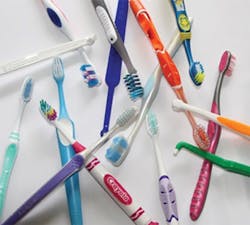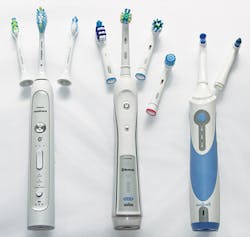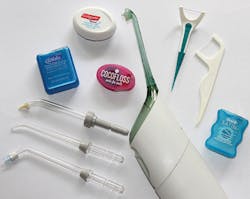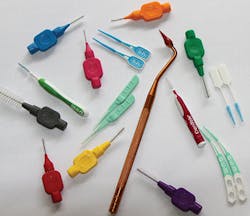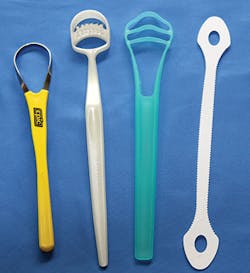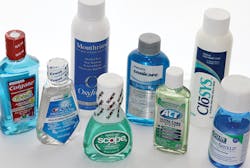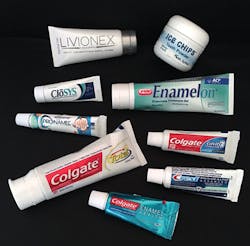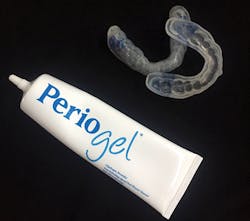Finding the silver lining in flossing fiasco: Home care tools lead the fight in biofilm disruption
By Anne Guignon, RDH, MPH, CSP
Several months ago, an Associated Press (AP) report stated flossing was not an important activity for overall oral health. Dental hygiene Facebook chat rooms went viral. Flossing, the dental hygiene sacred cow, was being attacked by those citing there was weak evidence as to the efficacy of this activity.
Clinicians have spent decades trying to convince patients to floss, but in reality, many don't. Many patients just tune us out every time we roll out the flossing sermon, hoping to create a new convert to a practice that many dental professionals consider essential. I don't blame them. For dozens of reasons, patients have chosen to dismiss our admonishments, but for many professionals our reputation is stuck on floss, so the AP article struck a chord.
The reporter did his job. He dug up an obscure change in the wording of the federal government's latest Dietary Guidelines for Americans, issued every five years. The flossing recommendation had been removed. Under the law, guidelines must be based on scientific evidence, and the government acknowledged the effectiveness of flossing had never been researched.
The media took a potshot at one home-care method, cited weak, short-term studies about flossing, and ignored the real topic, which should be effective biofilm disruption. So rather than getting up in arms and being reactive, why not see this media hype as a serious and welcome opportunity to have an actual patient-centered discussion, not one focused on a singular tool?
Orlando-area hygienist Stephanie Baker, RDH, was one of the first to voice a positive spin about the effects of the report in her clinical practice. "It's been a very interesting opportunity for discussion about alternatives. However, the best part may be the people who were suddenly interested in their oral health in general. Patients were engaged throughout the entire appointment, which made for education opportunities and a more intellectually stimulating day for me."
The real issues
If patients don't use floss, so what? The real issue is biofilm disruption and creating homeostasis so pathogenic microbes can't survive. Floss is only one tool. As professionals, we need to be flexible enough to come up with other solutions. There are dozens of other chemical or mechanical biofilm control devices and regimens that support a healthy mouth. When patients are healthy, we need to celebrate their successes and encourage them to continue to use what is working well, not grade them on whether or not they are using one singular method (e.g., floss).
Whether the patient is at risk for caries or periodontal disease, biofilm microbes have perfected the art of creating oral infections. Home-care activities should support and extend the outcomes of the in-office treatment. But despite our best intentions, patients can feel very disconnected from the process. For some, it takes every ounce of emotional energy to walk through the door of the dental office. Others only hear how, once again, their gums are bleeding or that they have to return for another restoration. Others feel like we are dictators or hung up on one single way to achieve health. How discouraging it must be to a patient to hear over and over that the plan is still not working!
Successful hygienists strive to bring the patient into the process. Consider focusing on what a patient is doing well. People love to hear that they are making progress. Intraoral photos are a quick and powerful way to deliver good news. Engaging a patient in a positive way sets the stage where you can take oral health coaching to the next level.
Meeting a patient at his or her level shows empathy, which leads to emotional buy-in by the patient. When patients know we care, they value our input and services at a higher level. While we all start with the endpoint in mind, it is important to remember that achieving optimal oral health is a process for most. Since everyone is different, say "bye bye" to the cookie-cutter approach, since there is no one right set of tools or tasks for everyone.
Complementary home-care strategies
Two complementary strategies can put your patient in charge of supporting his or her own oral health outcomes. First, it is important to physically reduce the microbial bioburden on a regular basis. Generally this involves the mechanical reduction of biofilm with devices like brushes and interdental devices, including string floss, oral irrigators, and tongue scrapers. In addition to mechanical disruption, there are a variety of products and protocols that use different chemistries to support homeostasis. In essence, using chemical means to inhibit biofilm formation or disrupt existing biofilm communities is another way to keep pathogens at bay.
Over time, most clinicians settle on a few home-care products or techniques that have proven useful. It is really easy to forget about a product that you've used only once or twice, never used yourself, worked with in your last office, or one that just came out since your last CE course. Before discussing actual patient strategies, here's a quick review of both mechanical and chemical tools that have been successful for many clinicians. If you've been keeping up, the next section will hold very few surprises, but it may jog your memory about some effective products or protocols that fell out of your daily routine.
Brushes-People all over the world have been using some sort of brushing device to clean their teeth for a very long time. In fact, a dried stick, called the miswack, has been used in the Middle East and Africa for years as a brushing device. Users chew the end, creating a fibrous scrubbing surface that contains natural antimicrobial substances.
Figure 1: Miswacks.
Figure 2: Conventional hand toothbrushes.
Figure 3: Power brushes.
Early brushes were made with stiff animal hair, while modern brushes are now made with delicate, soft nylon bristles. Initially toothbrushes had large heads, straight handles, and featured flat-trim brush heads. Fifty years ago, the standard toothbrush caught the attention of innovators and we now have a plethora of design options to suit every need.
Smaller, tapered brush heads fit better in posterior areas and work better for those with sensitive gag reflexes. End-tuft brushes are the ultimate mini-toothbrush devices, specifically designed to access hard-to-reach areas such as the distal of a maxillary molar or a tooth in linguoversion. Brushes with bi-level bristles are very popular. Longer bristles reach deeper interproximally and around complex orthodontic appliances, implants, or crown and bridge restorations, while the short bristles cleanse other surfaces. Handles have evolved as well. Many are made with a surface grip that makes it easy to hold, and others have a specific grip design that trains the user to position the brush at a 45-degree angle. In response to our on-the-go lifestyle, 1-inch, single-use, prepasted, disposable mini-toothbrushes provide a quick touch up.
The range of power brushes is stunning. There is everything from a simple spin brush to ultra-techie devices that use Bluetooth technology to record information such as how you are using a brush and where you are missing, complete with text reminders on how to improve your technique. While the new power brushes might seem quite fancy, those of us who practiced before power brushes were readily available certainly recall the dramatic changes we saw in our patients' oral health: reduced gingivitis and calculus, and much less dentinal hypersensitivity.
Floss-Conventional floss has long been the cornerstone of clinician recommendations. The first floss products were either waxed or unwaxed nylon string, similar to heavy sewing floss. Floss products soon morphed to include tape, Teflon floss, and niche products such as a mini sword-shaped device that holds the floss tightly between two plastic prongs. Y-shaped floss holders were developed to help people access hard-to-reach areas, and floss with compressible, fuzzy midsections help clean under fixed bridgework. Woven floss is soft and expands to trap biofilm, but tends to shred if it comes into contact with a rough restoration.
Figure 4: Conventional string floss products and water floss tips.
Two recent additions in the flossing arena are noteworthy. The first features a disposable floss insert that pops into the ends of two small nunchuck-shaped handles. The handles allow patients to control the floss without putting their fingers in their mouth; there is even a version configured to pass floss around orthodontic brackets. A new floss product made with a special woven polyester fiber uses coconut oil to lubricate tight contacts. The gentle fibers separate and expand to capture more biofilm than nylon floss.
Traditional powered oral irrigators, now referred to as water flossers, feature a graduated pressure control valve and have gained favor with professionals as appropriate devices for biofilm disruption. Patients who do not or will not use conventional floss or who have dexterity challenges are ideal candidates for these devices, as well as those with orthodontic appliances and fixed bridgework. A variety of irrigation tips, designed for specific debridement activities, are available for powered countertop models and portable battery-operated units. The tip is positioned so the irrigation fluid flows directly along the gum line and through the embrasure space at a comfortable pressure level. Devices that adapt to a showerhead utilize shower line water pressure. There are also certain circumstances where a squeeze-bottle with a cannula or a syringe can be used for site-specific nonpowered irrigation.
There is a unique battery-operated unit that uses a measured puff of compressed air to drive a small amount of liquid through interproximal spaces to dislodge biofilm. The tip is positioned so the air-liquid puff is directed through the embrasure space. Given the small amount of liquid used with this device, it can be the perfect answer for patients with gagging or swallowing issues.
Interproximal brushes, picks, and sticks-The number of site-specific products has grown tremendously over the years. In the early years, clinicians were limited to devices such as conventional toothpicks, triangular soft wooden sticks, plastic picks, and rubber-tip stimulators. Many improvements have been made to make the devices more user-friendly, sturdier, and more comfortable.
Figure 5: Picks, sticks, and interproximal brushes.
The first interproximal brushes came in various diameters that inserted into slim toothbrush-like handles. Users were frequently frustrated when the support wires bent or broke. New products are made with more flexible but durable wire supports. Interproximal picks with silicone projections have captured patients' attention everywhere. They are convenient, easy-to-use, and comfortable.
While many patients are drawn to using interproximal devices, it is important to make sure the device fits the challenge at hand. Through the years, many of us have seen blunted papillae that are a direct result of a device being forced repeatedly over time into a space that is too small. Conversely a small interproximal pick or brush is not going to do an adequate job of biofilm disruption when there is a wide-open space that can accommodate an extra-large interproximal brush.
Tongue cleaners-A growing number of patients are adopting daily tongue cleaning. Most are driven by the promise of sweeter, fresher breath, but reducing the overall bioburden benefits oral health. Tongue cleaner designs include a thin, flexible plastic strip with serrated ridges on the edge, molded rigid plastic tools with multiple scraping blades, and an oval metal scraping ring attached to a handle. Several oral irrigators also have adaptors to clean the tongue.
Figure 6: Tongue cleaners.
Mouth rinses-We all have patients that just want to rinse and spit and expect oral health problems to magically disappear down the drain. Patients need to know that most over-the-counter retail mouth rinses are cosmetic in nature and offer no therapeutic value. While chlorhexidine can be used at home, it is a prescription product not intended for day-in/day-out use.
Figure 7: Rinses.
Products formulated with essential oils, cetylpyridinium chloride (CPC), and chlorine dioxide all have demonstrated value in the battle against periodontal disease biofilm. Xylitol-based rinses and gels are helpful in stimulating salivary flow and help establish a neutral pH. Fluoride rinses are used to support remineralization of hard tooth structure.
Dentifrices and gels-Again, the challenge comes with understanding the long-term patient goals. Over-the-counter (OTC) fluoride toothpaste has been the gold standard for caries prevention for a half century. While stannous fluoride-containing dentifrices are known to have an antimicrobial effect on the cell walls of cariogenic microbes, pastes that contain triclosan formulations are recognized as the most powerful OTC antimicrobial option.
Some patients prefer dentifrices and gels that do not contain fluoride or traditional antimicrobials. Pastes and powders that contain xylitol are increasingly popular. One multicompound treatment gel uses a low level of stannous fluoride and amorphous calcium phosphate to fight gingivitis and promote remineralization. Ongoing research and compelling case studies are showing promising results from using a unique tooth gel that contains EDTA as a vehicle to drive essential biofilm-disrupting ingredients into the existing plaque matrix, lowering the adhesion to the tooth surface.
Many research studies have shown that arginine-based pastes help reduce caries activity in susceptible subjects and preliminary reports indicate that arginine may interfere with the adherence and structural integrity of some periodontal biofilms.
Customized delivery-Several well-designed clinical trials and numerous cases studies are creating an important discussion concerning delivery of 1.7% hydrogen peroxide gel directly into the sulcus using custom prescription trays. The trays are not the usual whitening tray design that stops at the cemento-enamel junction. Prescription trays are designed with a special seal to keep the concentration of the gel constant, thereby preventing dilution from crevicular fluid flow during the 10- to 15-minute wear time. Patients using this system not only appreciate the ease; compliance improves as they see the additional side effects of fresher breath and whiter teeth.
Figure 8: Dentifrices and gels.
Figure 9: Peroxide gel with custom tray.
Limiting factors and belief systems
Was that a short review? Not when you really try to think about all of the amazing home-care possibilities that clinicians and patients can discuss these days. On the flip side, think of how excited your patients will be when they find out that there are so many more options that they might never have heard about before.
Along with the importance of the emotional buy-in, consider that there may be physical limitations that make certain products or techniques impossible for a particular patient to use. Why set them up for failure or frustration? For example, a patient with huge hands or short, stubby fingers may have a terrible time using conventional floss. Imagine what might happen if they were offered interproximal picks that have a large, comfortable gripping pad, or they found out that an oral irrigator could be a reasonable alternative.
Many patients with arthritis have ongoing hand pain, so conventional subgingival and interproximal devices may be quite hard to manipulate. Since inflammation in any part of the body plays a big role in those with autoimmune disorders such as arthritis, daily use of peroxide gel prescription trays could be a wonderful option to keep periodontal inflammation at bay. In addition, the trays can be a helpful approach for caregivers charged with oral health tasks.
Those with sensitive gag reflexes are a challenge and will benefit from more compact devices of any sort. The chance of triggering the sensitive gag response goes way down when items such as brushes are less bulky.
Personal beliefs can also create some interesting discussions in the treatment room. When patients have strong, often long-held beliefs such as "Everyone has soft teeth in my family," or "I don't want any fluoride," or "I inherited gum disease from my dad," it can be hard to sway people to accept recommendations, especially on the first visit. Typically, it's a waste of time and effort to expect an instant convert just because you told them they needed to do a, b, or c, or that they needed xyz product. A less confrontational approach, along with the tincture of time, will often soften their views. There are reasons that they keep coming to see you. As a trusted problem solver, many will come around and at least consider what you are proposing.
Final thoughts
Years of clinical practice and too many workplace-related injuries challenged California-based Carrie Brown Ibbetson, RDH, to find new ways to put her years of clinical skills into practice. She decided to market herself as an oral hygiene coach, helping people and dental practices understand why they had continued oral disease and present them wit options that could improve their situation. Carrie's philosophy is simple: "Positive reinforcement is a wonderful way to improve patient retention in the practice. When you are able to help a patient with the basics, such as gum brushing, you take something they are already doing, such as tooth brushing, and help them achieve better results with the least amount of effort on their part. Over time, trust improves and engagement increases as patients notice a difference in the way their mouth feels, eventually accepting both the hygiene and restorative treatment recommendations."
Patients know when we are sincere, and patients know when we care. Rather than get all huffy about the potential disservice the AP article did to our floss message, open your mind and hearts to all of the other options for biofilm disruption and the potential for health. Your clinical days are bound to be a lot more fun when there is a new conversation. RDH
Conversational approaches to home care
Scolding, shaming, or dictating makes dental professionals look inflexible and never really supports long-term behavioral changes. Patient engagement involves getting the patient to buy in to a different technique, tool or protocol. The following phrases provide an easy entry to delivering new information in a much more user-friendly way and allow the patient to pick and choose between options.
• Have you ever tried ... ?
• Would you consider ... ?
• Here's a thought ...
• Some of my other patients have loved ...
• How does using an xyz device/tool/protocol sound?
• This might be an easy way to ...
• Would this work for you?
• Would this fit into your schedule?
• Here's a great way to confuse bacteria ...
• We now know ...
• Many other patients have liked/worked well with ...
Your colleagues react to "no need for flossing" story
• Jennifer Zimmerman, RDH, a veteran hygienist in McClain, Virginia, found that "patients all day asked about caries as an infection and the host-mediated response to periodontal disease. They started the conversation!"
• April Conaway, RDH, who has been practicing for six years in Wyoming, responded with, "I've had great discussions with patients all day about what constitutes effective flossing and the need to simply remove bacteria by whatever means works best for them."
• Stacey Fletcher, RDH, who works in public health in southwest rural Missouri, said, "I'm always looking for new ways to help my patients find sustainable oral health. For many reasons, flossing doesn't provide that for most people."
• Nicole Kielly, RDH, provides mobile dental hygiene services in St. John's, Newfoundland, Canada. She commented, "You gotta figure out what works for every patient. Flossing used to be the gold standard. Now I come at it from a 'get in there with something, anything' perspective. I don't care if it's a toothpick, floss sticks, yarn, air poofs, a shoelace. Patients have been really receptive."
ANNE NUGENT GUIGNON, RDH, MPH, CSP, provides popular programs, including topics on biofilms, power driven scaling, ergonomics, hypersensitivity, and remineralization. Recipient of the 2004 Mentor of the Year Award and the 2009 ADHA Irene Newman Award, Anne has practiced clinical dental hygiene in Houston since 1971, and can be contacted at [email protected].


